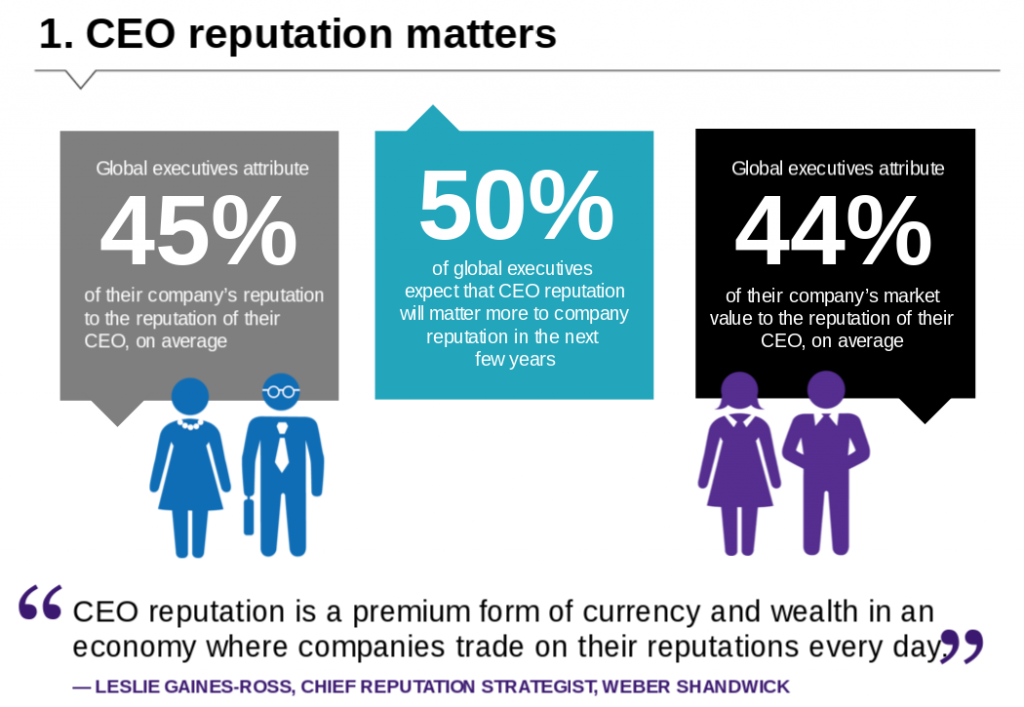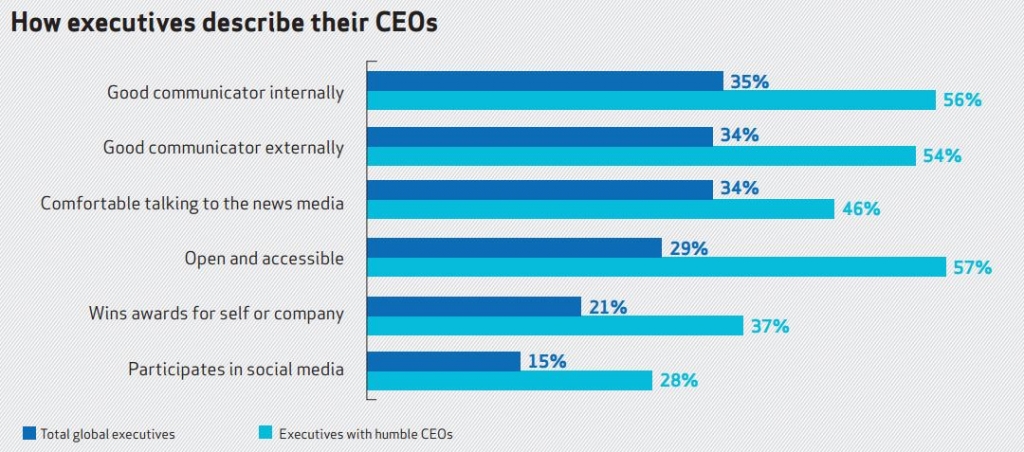It’s hard to argue that the past decade has been positive for CEOs and large multinational corporations. Between a global financial crisis, the spread of worldwide protest movements (such as Occupy Wall Street), and a massive backlash against executive-level compensation, companies — and their top leaders — have faced significant, consistent threats to their reputations.
As this is happening, though, long-term research consistently underscores that CEO reputation is one of the fundamental drivers of corporate reputation — and is virtually unwavering in terms of contribution to market value. This is a significant reality which should not be overlooked.
Despite the confluence of current events, a recent Weber Shandwick and KRC global survey of 1,750 executives in 19 markets found that CEO reputation still matters greatly. Consider the following data points and commentary from our partner Leslie Gaines-Ross, Chief Reputation Strategist at Weber Shandwick and a leading global expert in this important space.

Leslie calls these collective data points the CEO Reputation Premium.
The question that needs attention is, then: if CEO reputation is a growing competitive asset, how can senior leaders maximize this reputation premium?
Highly-regarded CEOs inspire confidence among stakeholders too: Consider how Don Thompson exited McDonald’s, for example. He was widely thought to not inspire, and that hurt the overall brand — and worried the stakeholders.
The “humble CEO” matters greatly: The traditional archetype of a CEO is a loud, dominant, Type-A, revenue-focused personality who demands greatness and adherence to goals and targets. This is gradually beginning to shift, however — and there are benefits to be seen, as our research indicates:

The “media elite” is starting to respect and cover this “humble CEO” dynamic more as well. Tim Cook (Apple) is a great example of this — but be careful to make sure you understand his approach correctly. Cook relentlessly keeps the focus on Apple — not himself. When he came out as gay in 2014, part of the reason it was such a major story is because he shuns the spotlight. The focus is Apple. It’s not Tim Cook. You don’t see that in every CEO, but that type of approach is becoming more common. And certainly it’s becoming much more appreciated.
The need for external profiles and engagement: 61 percent of Fortune 500 CEOs had no social presence at all, a statistic that echoes the findings of Weber Shandwick’s 2010 study,“Socializing Your CEO” (the first of three such reports). This isn’t necessarily surprising: CEOs are busy people with multiple commitments and stakeholders, and they often don’t see ROI from efforts like social media. (34% of CEOs say there’s no proof that it returns value, among the top reasons for not participating.) But like humble leadership, this too is becoming more common. John Legere, CEO of T-Mobile, has over 2 million followers on Twitter and often tweets pictures of putting together his breakfast and other seemingly mundane life events. In the process, he fosters a connection with potential consumers — and that connection pays dividends back to the brand.
Consider also the “social media crisis.” No company is immune to that in 2016. If one happens and your primary leader isn’t on social, it becomes much harder to manage — the CEO may not understand social and how it moves/flows, and in-house counsel and marketing may be confused about next steps. With an already engaged “social” leader, the process is smoother.
Engagement applies internally, as well. A CEO can’t be seen as an ivory tower figure among employees. This is obviously more challenging with 50,000 employees as opposed to five-ten, but it still must be done — even if it’s just through a weekly e-mail or something similar. The rank-and-file levels of your company — where the execution-level work gets done — needs to see a connection back to the CEO level, where the strategy is set.
What are the organizational implications for you?
If you’re a CEO, hopefully some of the above content is clear in terms of how you should position yourself both internally and externally.
Of course, not all of you reading this are CEOs. Where’s your implication?
In this case, you need to understand how leadership works — and how elements like “the humble CEO” and internal/external engagement apply at all leadership levels. Those aspects can drive retention (both employees and customers), referrals, and overall employee happiness. Remember: employees tend to leave bosses, not necessarily jobs.
At all levels, you also need to understand this idea that market share and market position are not solely the effect of financial metrics or revenue plays. Oftentimes, rather, they’re largely the effect of the reputation of the top leader. That’s extremely powerful — but also shows that you need to spend time on talent strategy, talent pipelines, and CEO messaging. Your financial planning stages probably didn’t include that before, but in a world where reputation is increasingly important as an aspect of market position, your revenue discussions need to take on new layers.









